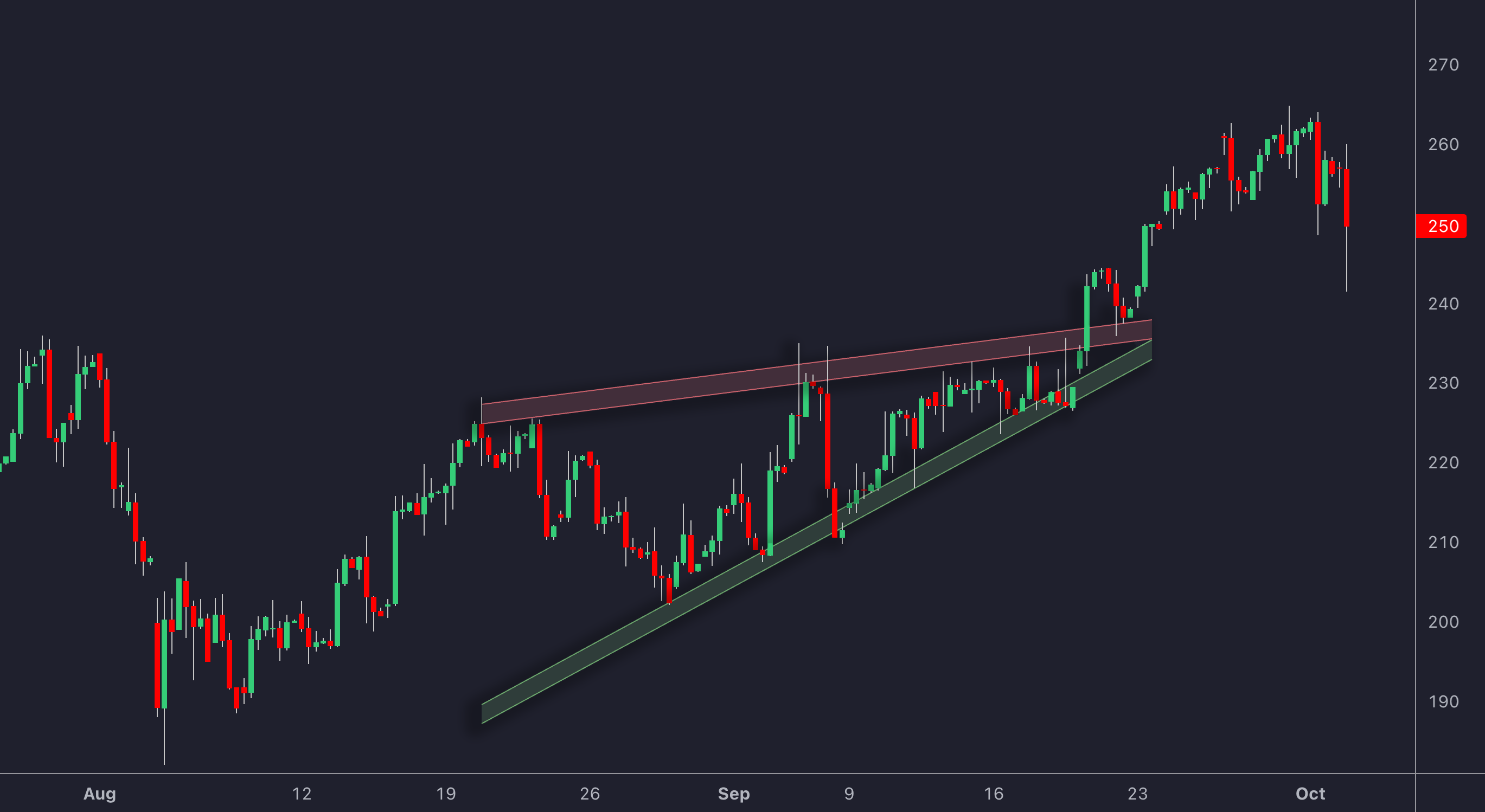Explore the fundamentals of harmonic patterns, including their structure, types, and trading strategies for identifying market reversals.
Harmonic patterns are a technical analysis method that helps traders identify potential market reversals using geometric price patterns and Fibonacci ratios. These patterns, like the Gartley, Bat, and Butterfly, rely on precise measurements to forecast turning points across forex, stocks, and commodities. Key benefits include:
- Predicting Reversals: Spot market turning points with measurable criteria.
- Defined Risk Levels: Set stop-loss points based on pattern structure.
- Versatility: Works across various markets and timeframes.
- Objectivity: Uses mathematical ratios, reducing personal bias.
Traders combine harmonic patterns with indicators like RSI or MACD for better accuracy. Platforms like LuxAlgo and TradingView simplify pattern detection, while proper risk management and timeframe selection ensure higher success rates. Ready to dive deeper? Let’s explore how to use these patterns effectively.
The Ultimate Beginner's Guide to Harmonic Patterns
Basic Principles
Harmonic patterns are built on two main ideas: Fibonacci ratios and the XABCD pattern structure. Together, these help traders spot potential market reversals.
Fibonacci Ratios in Pattern Formation
Key Fibonacci ratios like 0.618, 0.786, 1.27, and 1.618 define the relationships between different parts of a harmonic pattern. These ratios guide how retracements and extensions fit within the XABCD framework[1][2][3]. Essentially, they provide the blueprint for measuring and identifying patterns.
The XABCD Pattern Structure
Harmonic patterns use the XABCD structure, which includes five points and four price swings. These swings must align with Fibonacci ratios. The final point, D, is where traders expect a reversal, as it represents the area where multiple Fibonacci levels come together[2][4].
This convergence zone is the focal point for traders looking to act on these patterns. While identifying this manually can be complex, automated features (covered later) simplify the process by performing these calculations for you.
Main Pattern Types
Using the XABCD framework, these three patterns highlight how Fibonacci ratios are applied in trading strategies:
Gartley Pattern Guide

The Gartley pattern, first introduced in 1935, is one of the most dependable harmonic formations. It forms an "M" shape in bullish markets and a "W" shape in bearish markets.
| Component | Key Ratio |
|---|---|
| AB | 61.8% XA |
| CD | 127.2-161.8% BC |
This pattern is especially useful during consolidation phases, making it a key component for reversal strategies as outlined earlier [4][5].
Bat Pattern Analysis

The Bat pattern is known for its deeper retracements compared to the Gartley. Its hallmark is an 88.6% AD retracement of XA [4]. This pattern fits well with trending market conditions, as discussed within the XABCD framework. It requires an 88.6% AD retracement of XA, along with specific BC and CD extensions.
Butterfly Pattern Overview

The Butterfly pattern is distinctive due to its extended D point, which surpasses the original X point. This extension often indicates stronger reversals at market extremes [4][5].
| Feature | Ratio |
|---|---|
| AB | 78.6% XA |
| CD | 161.8-261.8% BC |
| AD | 127.2-161.8% XA |
This pattern is often found at the end of long trends or in overbought and oversold conditions. Its extended structure makes it highly reactive to momentum changes, a concept that will be applied in trading setup rules.
"The Butterfly pattern is valued for its ability to identify strong price reversals and provide clear entry and exit points" [4].
Pattern Trading Guide
Pattern Recognition Steps
To identify potential patterns using Fibonacci ratios, traders need to validate them with precise measurements. Focus on measuring Fibonacci ratios between swing points, ensuring that the alignment is accurate rather than prioritizing how often patterns occur.
Accuracy is key. A well-formed pattern should have clearly defined swing points and meet the Fibonacci ratio requirements within the specified range.
Trading Setup Rules
Once you’ve confirmed a valid pattern, apply the following trading parameters:
Entry Strategy:
- Wait for point D to form within the pattern's Fibonacci ratio guidelines.
- Use momentum indicators like RSI or MACD divergence to confirm entries.
- Look for additional confirmation on lower timeframes for better precision.
Stop-Loss Placement:
| Pattern Type | Stop-Loss Placement |
|---|---|
| Bullish Patterns | Place stop below point X |
| Bearish Patterns | Place stop above point X |
| Volatile Markets | Use ATR to calculate stops dynamically |
Position your stop-loss at the structural extremes of the pattern for added protection.
Profit Targets: Aim to take profits at 38.2%, 61.8%, and 100% retracement levels of the pattern range. This approach helps lock in gains at key levels.
Trading Software Options
Manual pattern identification can be effective, but software platforms can save time by automating Fibonacci measurements and pattern detection. Here are two popular options:
LuxAlgo: Pattern Detection Features

Price Action Concepts® includes an Automatic Pattern Detection feature able to detect various chart patterns as well as a dashboard to give users information about any detected pattern.
Key Features:
- Real-time pattern detection with 70-80% accuracy
- Customizable settings for enhanced analysis
- Visual overlays directly on charts
- Alerts across multiple timeframes
| Plan | Monthly Price | Features Included |
|---|---|---|
| Free | $0 for life | Access to hundreds of free tools on the LuxAlgo Library for 5+ charting platforms |
| Essential | $24.99 | Price action tools & screener for more simple analysis |
| Premium | $39.99 | Advanced signals, alerts, & oscillator tools for powerful technical analysis |
| Ultimate | $59.99 | AI Backtesting platform access to create strategies automatically and test them within Backtesters on TradingView |
TradingView Pattern Analysis

TradingView is a versatile platform that offers tools for manual pattern analysis, making it a great starting point for beginners.
Features:
- Customizable drawing tools for precise charting
- Built-in Fibonacci calculators
- Access to community-created indicators
- Multi-timeframe charting capabilities
TradingView operates on a freemium model, providing basic tools for free, with premium options starting at $14.95 per month. Its user-friendly interface makes it an excellent choice for practicing pattern recognition.
Some traders find that combining LuxAlgo’s automated features with TradingView’s manual capabilities provides a balanced approach for verifying signals and improving accuracy.
These platforms can streamline the analysis process, but choosing the right timeframe remains a critical step - something we'll explore in the next section.
Common Problems and Solutions
Harmonic patterns can offer structured trade setups, but dealing with market volatility requires careful adjustments to safeguard your trades.
Managing Market Volatility
Volatility can disrupt harmonic patterns through false breakouts and skewed ratios. Here are two practical ways to handle this:
- Use smaller position sizes during periods of high volatility to limit risk.
- Wait for the pattern to fully form before making a trade to avoid premature entries.
Research shows that combining harmonic patterns with momentum indicators can improve success rates in volatile markets [3].
Choosing Time Frames
Timeframe selection plays a major role in how reliable harmonic patterns are, especially across different asset classes. For instance, the Journal of Technical Analysis found that harmonic patterns had a 68% success rate in forex, compared to 62% in stocks and 58% in cryptocurrencies [4].
Time Frame Recommendations by Asset Class:
- Forex: Use 1-4 hour charts due to high liquidity.
- Cryptocurrencies: Focus on 4-hour or daily charts to account for their inherent volatility.
- Stocks: Stick to daily charts to better manage risks from price gaps.
This approach aligns with market structures and supports the versatility of harmonic patterns. For cryptocurrency traders, 4-hour charts are particularly useful because they account for the 24/7 market cycle, as discussed in earlier examples.
Summary and Next Steps
Now that we've covered pattern recognition and trading strategies, it's time to focus on putting this knowledge into action.
Key Skills to Develop
To effectively trade using harmonic patterns, you'll need to sharpen these three skills:
- Recognizing Patterns: Learn the XABCD structure and the Fibonacci ratios that define harmonic patterns. Start with the Gartley pattern, a good choice for beginners due to its reliability.
- Blending with Technical Analysis: Combine harmonic patterns with tools like Fibonacci ratios and momentum indicators. This layered approach can help you confirm potential reversal points and improve your decision-making.
- Managing Risk: Use position sizing rules that align with your account size and risk tolerance. Always set stop-loss orders near structural extremes, such as the X point in the XABCD pattern.
Steps for Practical Application
To incorporate harmonic patterns into your trading strategy, follow these steps:
Practice Phase
- Start by identifying patterns on historical charts, focusing on daily timeframes.
- Test your strategy by paper trading a single pattern type and keeping detailed notes in a trading journal.
Transition to Live Trading
- Begin with small position sizes (around 0.5-1% of your account).
- Use backtesting to refine your entry and exit strategies.
Success in harmonic trading requires patience and a commitment to consistent practice. Stick to the process, and you'll steadily build your skills and confidence.
FAQs
What is the rule for harmonic pattern?
Harmonic patterns rely on specific Fibonacci ratios between the XABCD points. These ratios define the structure of each pattern, as shown in the Gartley pattern ratios table above. Patterns must meet these retracement and extension criteria to be valid [1][2].
What is the best harmonic pattern to trade?
Among the various harmonic patterns, two are often highlighted for their reliability:
- Gartley Pattern: Known for its balanced structure and frequent appearance, making it a good choice for beginners.
- Bat Pattern: Provides clear entry points and well-defined stop-loss levels [4][5].
New traders usually prefer the Gartley pattern since it appears consistently across different markets and timeframes.
What is the success rate of harmonic pattern trading?
Research cited in Common Problems indicates that harmonic patterns have a 68% success rate in forex trading [4]. However, this performance depends on several factors:
- Correctly identifying patterns
- Effective risk management
- Understanding market conditions
- Using confirmation signals
These findings align with the earlier discussion on recommended timeframes [3][5].







